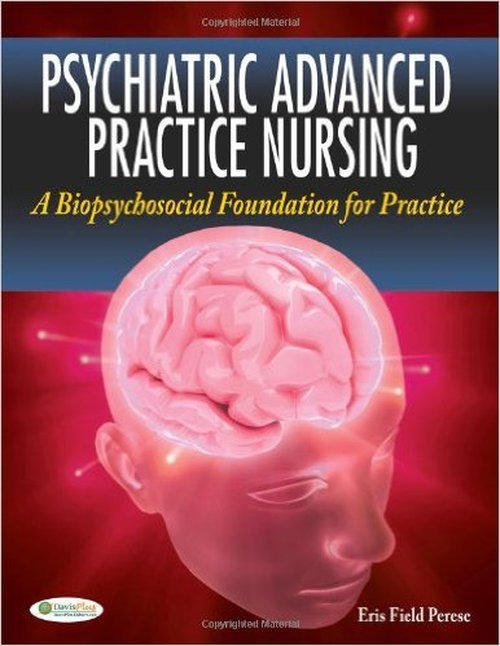Test Bank For Psychiatric Advanced Practice Nursing A Biopsychosocial Foundation 1st Edition
Original price was: $55.00.$35.00Current price is: $35.00.
Test Bank For Psychiatric Advanced Practice Nursing A Biopsychosocial Foundation offers a comprehensive overview of psychiatric nursing. It provides a biopsychosocial foundation for psychiatric advanced practice nursing, covering topics such as mental health assessment, diagnosis, and treatment planning. The book also includes chapters on psychiatric medications and psychotherapy.
Test Bank For Psychiatric Advanced Practice Nursing A Biopsychosocial Foundation is an essential resource for anyone interested in psychiatric nursing. It is an ideal text for both classroom use and self-study. Test Bank For Psychiatric Advanced Practice Nursing A Biopsychosocial Foundation is sure to help you understand and apply the biopsychosocial approach to psychiatric nursing.
Test Bank For Psychiatric Advanced Practice Nursing A Biopsychosocial Foundation 1st Edition is a great book that I would recommend to anyone who wants to learn about Psychiatric Nursing.
Description
Test Bank For Psychiatric Advanced Practice Nursing A Biopsychosocial Foundation 1st Edition
Chapter 2: Neurobiological Theory of Psychiatric Disorders: Brain functioning, brain development, and prenatal and perinatal factors disrupting brain development
Multiple Choice
Identify the choice that best completes the statement or answers the question.
____ 1. On evaluation, the patient appears to be having difficulty with working memory, planning, and insight into his problems. The psychiatric advanced practice nurse recognizes that these symptoms are associated with problems with the
|
A. |
Frontal lobe |
|
B. |
Temporal lobe |
|
C. |
Parietal lobe |
|
D. |
Occipital lobe |
____ 2. On mental status examination, the patient’s thoughts reveal lack of directedness, excessive details, and difficulty with closure. This pattern is called
|
A. |
Concrete thinking |
|
B. |
Circumstantiality |
|
C. |
Perseveration |
|
D. |
Thought blocking |
____ 3. The brain structure that is believed to have a gating/filtering function and is the area of the brain through which all sensory information passes en route to various cortical areas is which of the following:
|
A. |
Brainstem |
|
B. |
Reticular activating system |
|
C. |
Thalamus |
|
D. |
Hypothalamus |
____ 4. Which area of the brain is a very primitive in terms of evolution and is involved in swallowing, arousal, and breathing?
|
A. |
Parietal lobe |
|
B. |
Insula |
|
C. |
Cerebellum |
|
D. |
Brainstem |
____ 5. Which of these brain structures puts emotional meaning on a stimulus, forms emotional memories, and is involved with rage and fear?
|
A. |
Hippocampus |
|
B. |
Temporal lobe |
|
C. |
Amygdala |
|
D. |
Midbrain |
____ 6. The principal excitatory neurotransmitter in the central nervous system is
|
A. |
Gamma-aminobuytric acid (GABA) |
|
B. |
Serotonin |
|
C. |
Glutamate |
|
D. |
Acetylcholine |
____ 7. Which structure of the brain is involved in learning, processing information into memories, and assigning the time and the place to memories?
|
A. |
Hippocampus |
|
B. |
Olfactory bulb |
|
C. |
Limbic system |
|
D. |
Occipital lobe |
____ 8. Which one of the following is not one of the meninges, the three layers that cover the brain?
|
A. |
Arachnoid |
|
B. |
Pia |
|
C. |
Reticular formation |
|
D. |
Dura |
____ 9. Which of the following structures provides for communication between the two hemispheres of the brain?
|
A. |
Lateral ventricle |
|
B. |
Basal ganglia |
|
C. |
Corpus callosum |
|
D. |
Hypothalamus |
____ 10. Which of the lobes of the brain is primarily involved in auditory hallucinations?
|
A. |
Occipital lobe |
|
B. |
Parietal lobe |
|
C. |
Frontal lobe |
|
D. |
Temporal lobe |
____ 11. The function of this brain structure was formerly believed to be limited to maintaining balance and learning motor skills but is now believed to be involved in learning and emotions and may be involved in autism. It is the
|
A. |
Cerebellum |
|
B. |
Insula |
|
C. |
Corpus callosum |
|
D. |
Pons |
____ 12. This area of the brain is called a system and is made up of the rim of the medial (innermost) portions of the frontal, parietal, and temporal lobes and overlies the brainstem. It is involved with emotions and is referred to as the
|
A. |
Ventricular system |
|
B. |
Limbic system |
|
C. |
Reticular activating system |
|
D. |
Blood-brain barrier system |
Chapter 2: Neurobiological Theory of Psychiatric Disorders: Brain functioning, brain development and prenatal and perinatal factors disrupting brain development
Answer Section
MULTIPLE CHOICE
1. ANS: APTS:1
2. ANS: BPTS:1
3. ANS: CPTS:1
4. ANS: DPTS:1
5. ANS: CPTS:1
6. ANS: CPTS:1
7. ANS: APTS:1
8. ANS: CPTS:1
9. ANS: CPTS:1
10. ANS: DPTS:1
11. ANS: APTS:1
12. ANS: BPTS:1





Be the first to review “Test Bank For Psychiatric Advanced Practice Nursing A Biopsychosocial Foundation 1st Edition”